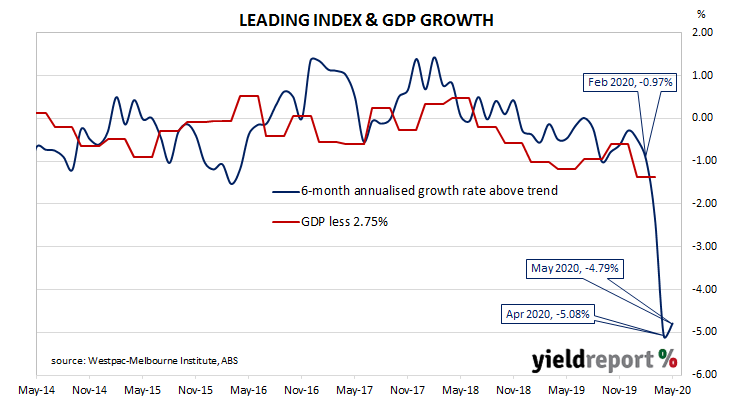Summary: leading index hits floor, bounces slightly in May; implies annual GDP growth to fall to ~-2.0% later this year; Westpac trims June quarter contraction to 7%; “deep recession is still forecast”.
Westpac and the Melbourne Institute describe their Leading Index as a composite measure which attempts to estimate the likely pace of Australian economic activity over the next three to six months. After reaching a peak in early 2018, the index trended lower through 2018, 2019 and the early months of 2020. A sharp drop came as expected in March and an even sharper fall followed in April.
The latest reading of the six months annualised growth rate of the indicator has increased from April’s revised figure of –5.08% to -4.79% in May.
“Despite the slight improvement, the Index growth rate remains in deep negative territory consistent with an economic recession,” said Westpac chief economist Bill Evans.
Index figures represent rates relative to trend-GDP growth, which is generally thought to be around 2.75% per annum. The index is said to lead GDP by three to six months, so theoretically the current reading represents an annualised GDP growth rate of around -2.0% sometime in the third or fourth quarters of 2020.
Commonwealth Government bond yields hardly moved, ignoring increases in US Treasury bond markets overnight. By the end of the day, 3-year and 10-year ACGB yields both remained unchanged at 0.28% and 0.94% respectively while the 20-year yield finished 1bp higher at 1.56%.
Prices of cash futures contracts moved to reflect a tiny hardening of rate-cut expectations. By the end of the day, July contracts implied a rate cut down to zero as a 59% chance, up from the previous day’s 57%. August contracts implied a 51% chance of such a move, up from 48%. Contract prices of months later in 2020 and through to mid-2021 implied similar probabilities, ranging between 39% and 55%.

